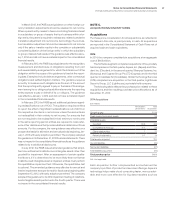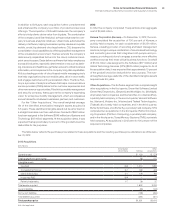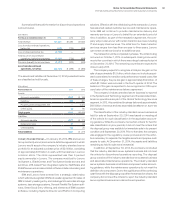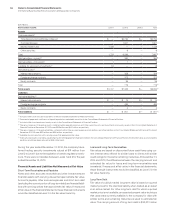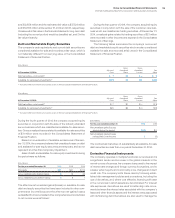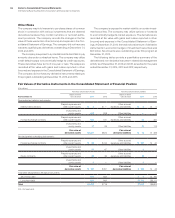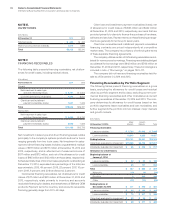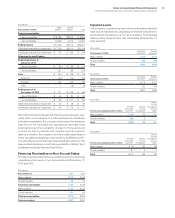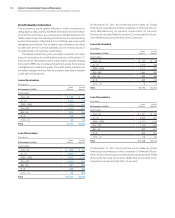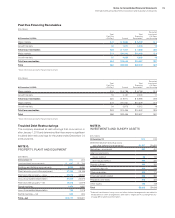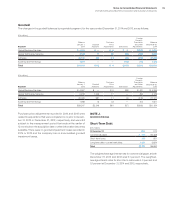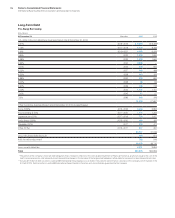IBM 2014 Annual Report Download - page 108
Download and view the complete annual report
Please find page 108 of the 2014 IBM annual report below. You can navigate through the pages in the report by either clicking on the pages listed below, or by using the keyword search tool below to find specific information within the annual report.Notes to Consolidated Financial Statements
International Business Machines Corporation and Subsidiary Companies
107
At December31, 2014 and 2013, net gains of approximately
$1 million (before taxes), respectively, were recorded in AOCI in
connection with cash flow hedges of the company’s borrowings.
Within these amounts, less than $1 million of gains, respectively,
are expected to be reclassified to net income within the next
12months, providing an offsetting economic impact against the
underlying transactions.
Foreign Exchange Risk
Long-Term Investments in Foreign Subsidiaries
(Net Investment)
A large portion of the company’s foreign currency denominated
debt portfolio is designated as a hedge of net investment in foreign
subsidiaries to reduce the volatility in stockholders’ equity caused
by changes in foreign currency exchange rates in the functional
currency of major foreign subsidiaries with respect to the U.S.
dollar. The company also uses cross-currency swaps and foreign
exchange forward contracts for this risk management purpose. At
December31, 2014 and 2013, the total notional amount of deriva-
tive instruments designated as net investment hedges was $2.2
billion and $3.0 billion, respectively. The weighted-average remain-
ing maturity of these instruments at December31, 2014 and 2013
was approximately 0.2 and 0.4years, respectively.
Anticipated Royalties and Cost Transactions
The company’s operations generate significant nonfunctional
currency, third-party vendor payments and intercompany pay-
ments for royalties and goods and services among the company’s
non-U.S. subsidiaries and with the parent company. In anticipation
of these foreign currency cash flows and in view of the volatility of
the currency markets, the company selectively employs foreign
exchange forward contracts to manage its currency risk. These
forward contracts are accounted for as cash flow hedges. The
maximum length of time over which the company is hedging its
exposure to the variability in future cash flows is four years. At
December31, 2014 and 2013, the total notional amount of forward
contracts designated as cash flow hedges of forecasted royalty
and cost transactions was $9.3 billion and $10.2 billion, respec-
tively, with a weighted-average remaining maturity of 0.7years for
both periods.
At December31, 2014 and 2013, in connection with cash flow
hedges of anticipated royalties and cost transactions, the com-
pany recorded net gains of $602 million and net losses of $252
million (before taxes), respectively, in AOCI. Within these amounts
$572 million of gains and $166 million of losses, respectively,
are expected to be reclassified to net income within the next
12months, providing an offsetting economic impact against the
underlying anticipated transactions.
Foreign Currency Denominated Borrowings
The company is exposed to exchange rate volatility on foreign
currency denominated debt. To manage this risk, the company
employs cross-currency swaps to convert fixed-rate foreign
currency denominated debt to fixed-rate debt denominated in
the functional currency of the borrowing entity. These swaps are
accounted for as cash flow hedges. The maximum length of time
over which the company hedges its exposure to the variability in
future cash flows is approximately seven years. At December31,
2014, no instruments relating to this program were outstanding.
At December31, 2013, the total notional amount of cross cur-
rency swaps designated as cash flow hedges of foreign currency
denominated debt was $1.2 billion.
At December31, 2014 and 2013, in connection with cash flow
hedges of foreign currency denominated borrowings, the com-
pany recorded net losses of $2 million and net losses of $9 million
(before taxes) in AOCI, respectively. Within these amounts, less than
$1million and $3 million of losses, respectively, are expected to be
reclassified to net income within the next 12 months, providing an
offsetting economic impact against the underlying exposure.
Subsidiary Cash and Foreign Currency
Asset/Liability Management
The company uses its Global Treasury Centers to manage the
cash of its subsidiaries. These centers principally use currency
swaps to convert cash flows in a cost-effective manner. In addi-
tion, the company uses foreign exchange forward contracts to
economically hedge, on a net basis, the foreign currency exposure
of a portion of the company’s nonfunctional currency assets and
liabilities. The terms of these forward and swap contracts are gen-
erally less than one year. The changes in the fair values of these
contracts and of the underlying hedged exposures are generally
offsetting and are recorded in other (income) and expense in the
Consolidated Statement of Earnings. At December31, 2014 and
2013, the total notional amount of derivative instruments in eco-
nomic hedges of foreign currency exposure was $13.1 billion and
$14.7 billion, respectively.
Equity Risk Management
The company is exposed to market price changes in certain broad
market indices and in the company’s own stock primarily related to
certain obligations to employees. Changes in the overall value of
these employee compensation obligations are recorded in SG&A
expense in the Consolidated Statement of Earnings. Although not
designated as accounting hedges, the company utilizes deriva-
tives, including equity swaps and futures, to economically hedge
the exposures related to its employee compensation obligations.
The derivatives are linked to the total return on certain broad
market indices or the total return on the company’s common
stock. They are recorded at fair value with gains or losses also
reported in SG&A expense in the Consolidated Statement of Earn-
ings. At December31, 2014 and 2013, the total notional amount of
derivative instruments in economic hedges of these compensation
obligations was $1.3 billion for both periods.


